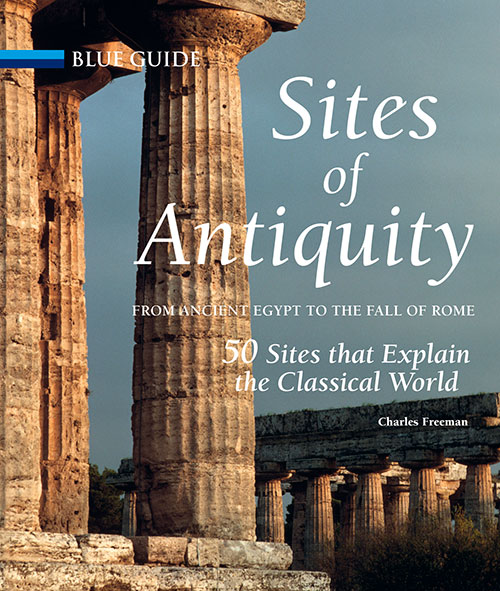
Sites of Antiquity
Brilliant!
Reviewed by Jesse Robertson
Format: Hardcover
Concise and encyclopedia-like with highlights of each site through panel discussions and photos. Each site is a survey point in a bigger picture look at life in antiquity. Beautiful photos. Authoritative narrative.

Sites of Antiquity
Review
Reviewed by TheHillpaul
Format: Hardcover
Apart from my passport the only other thing that has gone around the world with me has been a Blue Guide. There are other guidebooks that will give you better, cheaper or groovier places to eat and sleep but a Blue Guide is like Kipling’s six honest serving men. Having said that though this isn’t one that you would stuff in your knapsack. This is the luxury planning version that you may want to flip the pages on, peering through your monocle whilst reclining languidly on your chaise-longue. Unlike my dog-eared Blue Guides with their extensive marginalia, I will endeavour to keep this in the pristine condition I received it in. An excellent overview of the Classical world, it does a very good job of linking the major sites. The only caveat I have is that unlike the traditional Blue Guides the number of site maps/architectural illustrations is minimal, but don’t let that put you off.

Sites of Antiquity
Surprisingly accessible
Reviewed by justtryingtobehelpful
Format: Hardcover
I confess to be a bit of a history dunce and ruins don’t really do that much for me … HOWEVER, when I read this book several scales fell from my eyes and I found myself galloping through the text even and retaining some of the info. Charles Freeman’s style is incredibly readable. It’s also a truly beautiful book – glorious pictures, photographs, explanatory diagrams. I’m now on my way to Turkey … in my armchair of course.

Sites of Antiquity
A great book to drool over while planning your next five summers
Reviewed by Michael K. Smith
Format: Hardcover
When it comes to subjects like history, I’m always a little suspicious of glossy, oversized picture books because so many of them stint on the text. You have to ask, “Would this still be a worthwhile book without the images?” In this case, I’m pleased to say, the answer is resoundingly “Yes.” The text in this well-produced volume does not merely accompany and identify the hundreds of illustrations, it expands on them. Freeman identifies fifty locations of historical importance, places where there’s still something to be seen, where the classical past wasn’t obliterated by later history. You can argue with some of his choices, but since he limits himself necessarily to that number, his selections all are defensible. Some are pretty obvious, like the Forum in Rome, and the Acropolis in Athens, and the Great Pyramid in Egypt, but others will likely be new to most readers, such as the beautifully preserved Greek sanctuary and theater at Epidaurus and the mosaic-rich Roman villa at Piazza Armerina in Sicily. Chronologically, the range is from the step pyramid at Saqqara to St. Catherine’s Monastery in the Sinai. Geographically, “antiquity” is defined here as “Western” and he excludes anyplace east of Palmyra.
The illustrations, none of which are original for this volume, come from a number of sources, including not only archives and museums but individuals. Principal among these is a talented architectural photographer who traveled widely in the 1970s, camera in hand, and whose very high-quality work has seldom been seen before this. Reproduction of all the photos is very clear and they’re all of a size to show detail clearly. Freeman himself is what’s called a “freelance academic,” which means he has to know how to communicate clearly to nonspecialists (as well as being to market himself convincingly). I have a considerable background myself in classical history and I spotted no obvious errors or peculiar interpretations. I’ve visited some of these sites myself, over the years, and what he has to say brings back memories. There are numerous sidebars on such topics as the Greek philosophical schools and architectural “orders,” Egyptian religious themes, and Roman water supply management. He also adds a number of ground plans keyed to the photos for places like Rome and Olympus, which helps orient the reader. The only complaint I can make is that Freeman has a tendency to toss out technical terms (especially architectural jargon) without explanation. The glossary is only two pages, which should have been tripled, at least. Other than that small caveat, this is an very nicely conceived and generally very successful attempt to engage the reader in those complex civilizations that preceded ours.

Sites of Antiquity
Armchair grand tour
Reviewed by P Furtado
Format: Hardcover
This is a beautiful, accessible illustrated book which really brings the Blue Guide imprint up to date. It offers a spin round the great classical sites of the Mediterranean and the Nile, plus a couple of Roman sites – Trier and Hadrian’s Wall – much further north. Each site is treated to a crisp introduction to the history and its excavation, when relevant, and each article is boosted with factboxes and sidebards contextualising and explaining what it was all about. Plus of course a range of gorgeous photos, some historic prints and a few reconstruction artworks.
You might feel there are a lot of books answering to a description like that, but this one stands out by being written by an author with real knowledge and a great deal of experience at explaining the things the reader/visitor really wants to know, as well as the things the reader or visitor ought to want to know.
You wouldn’t want to take it with you on a hot day in Karnak – too big and too heavy and not enough specific detail to be worth the effort – but you can buy a traditional Blue Guide for that. Instead, study it – and enjoy it – at home, or in your cruise cabin.







